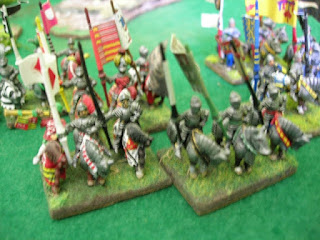The armour worn by my Medieval figures confines them to the period after 1400.
Chevaliers français
The ideals of knighthood did not wither as rapidly in France as in other parts of Europe, and the King could still assemble large numbers of well-trained nobles. Despite being persistently massacred at Crecy, Poitiers and Agincourt, French knights were always ready to charge.
The ideals of knighthood did not wither as rapidly in France as in other parts of Europe, and the King could still assemble large numbers of well-trained nobles. Despite being persistently massacred at Crecy, Poitiers and Agincourt, French knights were always ready to charge.
Nonetheless, against an English opponent, I prefer to dismount them (a tactic already used as early as 1346, and generalised after Agincourt).
Sergents à cheval
These are valets, squires and less enthusiastic knights.
These are valets, squires and less enthusiastic knights.
Arbalétriers et archers
The bulk of the infantry is feudal : communes and peasants who owe military service to their lord and are required to acquit it when the King calls out the host.
The bulk of the infantry is feudal : communes and peasants who owe military service to their lord and are required to acquit it when the King calls out the host.
Several mid-14th century charters show that the French kings wished that the towns (communes) would act with greater independance, but that they generally refused ! This is the opposite attitude to that encountered in England, in the Low Countries, in Burgundy, Italy or the Empire.
Urban militia therefore form but a minor part of French armies. They are complemented with Spanish crossbowmen from Aragon and Navarre, or Genoese mercenaries.
Mercenaires et Bretons (HI, MI)
My HI mercenaries represent "Brigans" (as well as some Navarrese). As far as I can make out, the name "Brigans" derives from the nickname given to Italian footsloggers, serving in French armies during the initial phases of the Hundred Year's War. Fighting in deep ranks with long spears (they are rated Ax(X) at DBM) they translate as HI in DSC.
My HI mercenaries represent "Brigans" (as well as some Navarrese). As far as I can make out, the name "Brigans" derives from the nickname given to Italian footsloggers, serving in French armies during the initial phases of the Hundred Year's War. Fighting in deep ranks with long spears (they are rated Ax(X) at DBM) they translate as HI in DSC.
The Breton MI are interesting troops to use, and often wrong-foot opponents. They give the French army the ability to invest and defend rougher going, which means the army can anchor one of its flanks.
Tactics
The army deployed against the majority of opponents is not a subtle one ! The mercenaries or Brigans will anchor one flank. There is only one location for the knights, and that is in the centre. They are of course placed under the commander-in-chief, and their impetuous nature tends to quickly decide a battle, one way or another. The very first game of Medieval DSC that I played lasted only two turns !
If there is a flank where terrain is rougher, the idea is for the Brigans and Bretons to take control of or neutralise it. When this is done the knights will charge, their flank now anchored and protected. If the Brigans fail in their mission...the knights charge anyway, and may the flanks be damned !





Aucun commentaire:
Enregistrer un commentaire